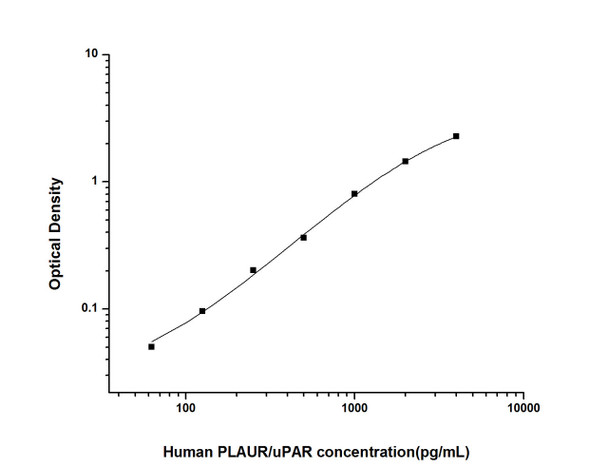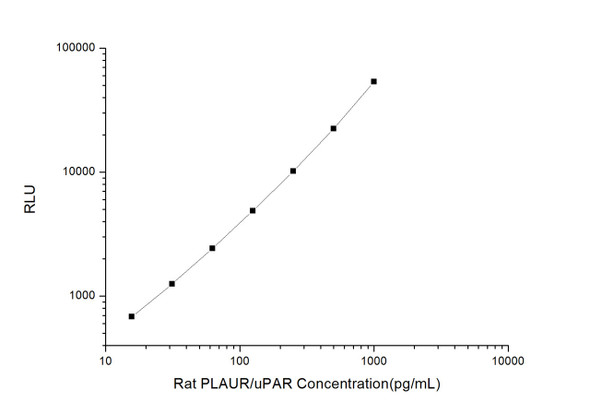Human Cell Biology ELISA Kits 1
Human PLAUR/uPAR (Plasminogen Activator, Urokinase Receptor) ELISA Kit (HUES02608)
- SKU:
- HUES02608
- Product Type:
- ELISA Kit
- Size:
- 96 Assays
- Uniprot:
- Q03405
- Sensitivity:
- 37.5pg/mL
- Range:
- 62.5-4000pg/mL
- ELISA Type:
- Sandwich
- Synonyms:
- CD87, U-PAR, URKR
- Reactivity:
- Human
- Sample Type:
- Serum, plasma and other biological fluids
- Research Area:
- Cell Biology
Description
| Assay type: | Sandwich |
| Format: | 96T |
| Assay time: | 4.5h |
| Reactivity: | Human |
| Detection Method: | Colormetric |
| Detection Range: | 62.50-4000 pg/mL |
| Sensitivity: | 37.50 pg/mL |
| Sample Volume Required Per Well: | 100µL |
| Sample Type: | Serum, plasma and other biological fluids |
| Specificity: | This kit recognizes Human PLAUR/uPAR in samples. No significant cross-reactivity or interference between Human PLAUR/uPAR and analogues was observed. |
This ELISA kit uses Sandwich-ELISA as the method. The micro ELISA plate provided in this kit has been pre-coated with an antibody specific to Human PLAUR/uPAR. Standards or samples are added to the appropriate micro ELISA plate wells and combined with the specific antibody. Then a biotinylated detection antibody specific for Human PLAUR/uPAR and Avidin-Horseradish Peroxidase (HRP) conjugate are added to each micro plate well successively and incubated. Free components are washed away. The substrate solution is added to each well. Only those wells that contain Human PLAUR/uPAR, biotinylated detection antibody and Avidin-HRP conjugate will appear blue in color. The enzyme-substrate reaction is terminated by adding Stop Solution and the color turns yellow. The optical density (OD) is measured spectrophotometrically at a wavelength of 450 nm ± 2 nm. The OD value is proportional to the concentration of Human PLAUR/uPAR. The concentration of Human PLAUR/uPAR in samples can be calculated by comparing the OD of the samples to the standard curve.
| UniProt Protein Function: | uPAR: Acts as a receptor for urokinase plasminogen activator. Plays a role in localizing and promoting plasmin formation. Mediates the proteolysis-independent signal transduction activation effects of U-PA. It is subject to negative-feedback regulation by U-PA which cleaves it into an inactive form. Monomer (Probable). Interacts with MRC2. Interacts (via the UPAR/Ly6 domains) with SRPX2. Expressed in neurons of the rolandic area of the brain. Expressed in the brain. 3 isoforms of the human protein are produced by alternative splicing. |
| UniProt Protein Details: | Protein type:Motility/polarity/chemotaxis; Receptor, misc. ; Membrane protein, GPI anchor Chromosomal Location of Human Ortholog: 19q13 Cellular Component: endoplasmic reticulum membrane; focal adhesion; extrinsic to membrane; integral to plasma membrane; endoplasmic reticulum lumen; plasma membrane; integral to membrane Molecular Function:protein domain specific binding; protein binding; enzyme binding; U-plasminogen activator receptor activity; receptor activity; receptor binding Biological Process: fibrinolysis; cellular protein metabolic process; regulation of proteolysis; attachment of GPI anchor to protein; C-terminal protein lipidation; post-translational protein modification; cell motility; chemotaxis; signal transduction; blood coagulation |
| NCBI Summary: | This gene encodes the receptor for urokinase plasminogen activator and, given its role in localizing and promoting plasmin formation, likely influences many normal and pathological processes related to cell-surface plasminogen activation and localized degradation of the extracellular matrix. It binds both the proprotein and mature forms of urokinase plasminogen activator and permits the activation of the receptor-bound pro-enzyme by plasmin. The protein lacks transmembrane or cytoplasmic domains and may be anchored to the plasma membrane by a glycosyl-phosphatidylinositol (GPI) moiety following cleavage of the nascent polypeptide near its carboxy-terminus. However, a soluble protein is also produced in some cell types. Alternative splicing results in multiple transcript variants encoding different isoforms. The proprotein experiences several post-translational cleavage reactions that have not yet been fully defined. [provided by RefSeq, Jul 2008] |
| UniProt Code: | Q03405 |
| NCBI GenInfo Identifier: | 465003 |
| NCBI Gene ID: | 5329 |
| NCBI Accession: | Q03405. 1 |
| UniProt Secondary Accession: | Q03405,Q12876, Q15845, Q16887, Q6IB52, Q9BWT0, Q9NYC8 Q9UD69, Q9UEA6, Q9UM92, Q9UMV0, A8K409, |
| UniProt Related Accession: | Q03405 |
| Molecular Weight: | 32,016 Da |
| NCBI Full Name: | Urokinase plasminogen activator surface receptor |
| NCBI Synonym Full Names: | plasminogen activator, urokinase receptor |
| NCBI Official Symbol: | PLAUR |
| NCBI Official Synonym Symbols: | CD87; UPAR; URKR; U-PAR |
| NCBI Protein Information: | urokinase plasminogen activator surface receptor; monocyte activation antigen Mo3; u-plasminogen activator receptor form 2; urokinase-type plasminogen activator (uPA) receptor |
| UniProt Protein Name: | Urokinase plasminogen activator surface receptor |
| UniProt Synonym Protein Names: | Monocyte activation antigen Mo3; CD_antigen: CD87 |
| Protein Family: | Urokinase plasminogen activator surface receptor |
| UniProt Gene Name: | PLAUR |
| UniProt Entry Name: | UPAR_HUMAN |
As the OD values of the standard curve may vary according to the conditions of the actual assay performance (e. g. operator, pipetting technique, washing technique or temperature effects), the operator should establish a standard curve for each test. Typical standard curve and data is provided below for reference only.
| Concentration (pg/mL) | O.D | Average | Corrected |
| 4000 | 2.308 2.34 | 2.324 | 2.265 |
| 2000 | 1.477 1.525 | 1.501 | 1.442 |
| 1000 | 0.864 0.85 | 0.857 | 0.798 |
| 500 | 0.41 0.434 | 0.422 | 0.363 |
| 250 | 0.271 0.249 | 0.26 | 0.201 |
| 125 | 0.159 0.151 | 0.155 | 0.096 |
| 62.50 | 0.106 0.112 | 0.109 | 0.05 |
| 0 | 0.058 0.06 | 0.059 | -- |
Precision
Intra-assay Precision (Precision within an assay): 3 samples with low, mid range and high level Human PLAUR/uPAR were tested 20 times on one plate, respectively.
Inter-assay Precision (Precision between assays): 3 samples with low, mid range and high level Human PLAUR/uPAR were tested on 3 different plates, 20 replicates in each plate.
| Intra-assay Precision | Inter-assay Precision | |||||
| Sample | 1 | 2 | 3 | 1 | 2 | 3 |
| n | 20 | 20 | 20 | 20 | 20 | 20 |
| Mean (pg/mL) | 201.93 | 425.28 | 1966.23 | 206.79 | 443.41 | 1782.56 |
| Standard deviation | 11.67 | 21.65 | 91.43 | 14.43 | 21.73 | 75.58 |
| C V (%) | 5.78 | 5.09 | 4.65 | 6.98 | 4.90 | 4.24 |
Recovery
The recovery of Human PLAUR/uPAR spiked at three different levels in samples throughout the range of the assay was evaluated in various matrices.
| Sample Type | Range (%) | Average Recovery (%) |
| Serum (n=5) | 92-105 | 100 |
| EDTA plasma (n=5) | 96-108 | 101 |
| Cell culture media (n=5) | 93-107 | 100 |
Linearity
Samples were spiked with high concentrations of Human PLAUR/uPAR and diluted with Reference Standard & Sample Diluent to produce samples with values within the range of the assay.
| Serum (n=5) | EDTA plasma (n=5) | Cell culture media (n=5) | ||
| 1:2 | Range (%) | 89-101 | 99-111 | 95-106 |
| Average (%) | 96 | 105 | 100 | |
| 1:4 | Range (%) | 89-103 | 86-98 | 85-99 |
| Average (%) | 95 | 93 | 91 | |
| 1:8 | Range (%) | 90-106 | 84-99 | 85-99 |
| Average (%) | 97 | 91 | 91 | |
| 1:16 | Range (%) | 86-101 | 79-93 | 83-97 |
| Average (%) | 93 | 85 | 88 |
An unopened kit can be stored at 4°C for 1 month. If the kit is not used within 1 month, store the items separately according to the following conditions once the kit is received.
| Item | Specifications | Storage |
| Micro ELISA Plate(Dismountable) | 8 wells ×12 strips | -20°C, 6 months |
| Reference Standard | 2 vials | |
| Concentrated Biotinylated Detection Ab (100×) | 1 vial, 120 µL | |
| Concentrated HRP Conjugate (100×) | 1 vial, 120 µL | -20°C(shading light), 6 months |
| Reference Standard & Sample Diluent | 1 vial, 20 mL | 4°C, 6 months |
| Biotinylated Detection Ab Diluent | 1 vial, 14 mL | |
| HRP Conjugate Diluent | 1 vial, 14 mL | |
| Concentrated Wash Buffer (25×) | 1 vial, 30 mL | |
| Substrate Reagent | 1 vial, 10 mL | 4°C(shading light) |
| Stop Solution | 1 vial, 10 mL | 4°C |
| Plate Sealer | 5 pieces | |
| Product Description | 1 copy | |
| Certificate of Analysis | 1 copy |
- Set standard, test sample and control (zero) wells on the pre-coated plate and record theirpositions. It is recommended to measure each standard and sample in duplicate. Note: addall solutions to the bottom of the plate wells while avoiding contact with the well walls. Ensuresolutions do not foam when adding to the wells.
- Aliquot 100µl of standard solutions into the standard wells.
- Add 100µl of Sample / Standard dilution buffer into the control (zero) well.
- Add 100µl of properly diluted sample (serum, plasma, tissue homogenates and otherbiological fluids) into test sample wells.
- Cover the plate with the sealer provided in the kit and incubate for 90 min at 37°C.
- Aspirate the liquid from each well, do not wash. Immediately add 100µL of BiotinylatedDetection Ab working solution to each well. Cover the plate with a plate seal and gently mix. Incubate for 1 hour at 37°C.
- Aspirate or decant the solution from the plate and add 350µL of wash buffer to each welland incubate for 1-2 minutes at room temperature. Aspirate the solution from each well andclap the plate on absorbent filter paper to dry. Repeat this process 3 times. Note: a microplatewasher can be used in this step and other wash steps.
- Add 100µL of HRP Conjugate working solution to each well. Cover with a plate seal andincubate for 30 min at 37°C.
- Aspirate or decant the solution from each well. Repeat the wash process for five times asconducted in step 7.
- Add 90µL of Substrate Reagent to each well. Cover with a new plate seal and incubate forapproximately 15 min at 37°C. Protect the plate from light. Note: the reaction time can beshortened or extended according to the actual color change, but not by more than 30min.
- Add 50 µL of Stop Solution to each well. Note: Adding the stop solution should be done inthe same order as the substrate solution.
- Determine the optical density (OD value) of each well immediately with a microplate readerset at 450 nm.






